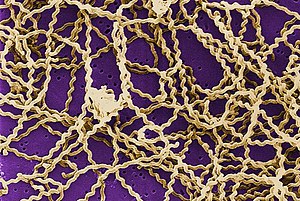Getting to know pathogens
Welcome to Getting to know pathogens. This is an introduction to basic concepts related to disease-causing micro-organisms.

Chapter readings are from "Medical Microbiology" by P. R. Murray, K. S. Rosenthal, G. S. Kobayashi and M. A. Pfaller (4th Edition) Mosby Inc. 2002 ISBN 0323012132. You can probably find used copies for a low price.
Another option is "Medical Microbiology" (Samuel Baron, editor) which is available online (free) or as a CD-ROM] ($10).
Host-microbe interactions
editThe interaction of humans with disease-causing bacteria is often thought of in terms of a host-invader interaction. However, there are many types of human-microbe interactions, so we need a more complex understanding of micro-organisms and their roles in normal human health and disease processes. It is useful to think in evolutionary terms. The various types of human-microbe interactions are the result of hundreds of millions of years of interactions between animals and micro-organisms. There are 3 main types of pathogen: bacteria, viruses and fungi. Not all bacteria and fungi are pathogens - pathogens are microbes that cause disease.
Host Susceptibility
edit- Reading (Chapter 1)
Strict pathogens
editSome (relatively few) microbes can infect essentially all human hosts who are exposed to the particular microbe AND cause essentially the same sort of infection and disease symptoms in every infected person. “Strict pathogens”
- examples: Treponema pallidum (syphilis); HIV (AIDS); Plasmodium vivax (malaria)
Discussion.
- What percent of people who are infected with Treponema pallidum show symptoms of syphilis?
- Does HIV infection always cause AIDS?
- How does genetic background influence the incidence and severity malaria?
Opportunistic pathogens
editMost microbes are more efficient at infecting some people than others and many microbes can cause several different types of disease depending on the type of infection (for example, depending on the site of infection) and variations in host-microbe interactions. “Opportunistic pathogens”
- example, Escherichia coli
- Discussion. Escherichia coli is a very common type of bacteria that normally lives in close contact with humans. Under what special circumstances can Escherichia coli cause human disease?
Human variability
editWe often speak of "the human body" and "human-microbe interactions" but it is wrong to think that all people have similar interactions with micro-organisms. It is important to keep in mind the full spectrum of human variability.
Sources of variation in host susceptibility to microbes:
- variation in nutritional status,
- variation in levels of stress and circulating stress hormones,
- variation in genes that confer resistance to microbes,
- variations in somatic cell mutations involved in immune system function,
- physical damage to tissues can open tissue barriers that normally limit microbial infections.
- Behavioral differences. Some behaviors promote health and avoid pathogens, other behaviors damage defenses and bring people into contact with pathogenic microbes.
- Example: intravenous drug use allows exposure to disease-causing microbes.
General Properties of Infections
edit- Reading (Chapter 9)
normal microflora
editMany microbial infections are called “endogenous infections” because they are caused by microbes that normally are found on the surface of human hosts.
- Types of colonization-
- not harmful:
- Transient colonization.
- Permanent colonization.
- not harmful:
Each surface of the body has its own population of typical microbes.
Often, these are protective against harmful microbes.
- harmful, disease causing:
- damage to the host by the microbe
- disruption of normal host tissue functions due to immune system response to an otherwise harmless microbe.
- harmful, disease causing:
example: Lactobacillus species are generally harmless GI tract microbes. Some antibiotics reach high levels in the GI tract and can greatly reduce or eliminate the normal gut microbes. Opportunistic disease-causing organisms such as Clostridium difficle can then proliferate and cause disease.
Discussion Topic
Prospects for maintaining normal (protective) microbial flora.
- a. Diet.
- b. Replacement of bacteria after exposure to antibiotics.
Example: Aspergillosis is caused by a fungus (Aspergillus), which is found commonly growing on dead leaves, stored grain, compost piles, or other decaying vegetation. Healthy humans are not susceptible to Aspergillus. Those at risk for Aspergillosis include immunosuppressed people such as organ transplant recipients, people being treated for cancer, and AIDS patients Aspergillus can also cause illness by colonization and growth in a lung cavity that was damaged by previous disease such as tuberculosis. When growing in the lung it produces a fungus ball called aspergilloma. The lung colonization can also progress to clinical pneumonia and invasive infection that is spread to other parts of the body by the blood stream (Pulmonary aspergillosis; invasive type).
Comments:
Josh Wright: 19th October 2006 10:24 EAST.
One day, the whole world will die from virus's. The only help, people who study them, and know how to treat, a research antivaccines to cure them. I think that we need to put more effort into researching virus's, and pathogens, and then we will one day be able to save the world from complete death.
- Are viruses all bad? Much of the genetic difference between humans and chimps has come about by way of insertions and deletions. A significant portion of human genetic change is due to the large amount of virus-derived sequence in the human genome (see). In addition to playing an important role in the rate of evolution of existing species, some hypotheses suggest that viruses played a fundamental role in the origin of cellular life as we know it; see: Three RNA cells for ribosomal lineages and three DNA viruses to replicate their genomes: A hypothesis for the origin of cellular domain by Patrick Forterre. --JWSchmidt 12:57, 19 October 2006 (UTC)